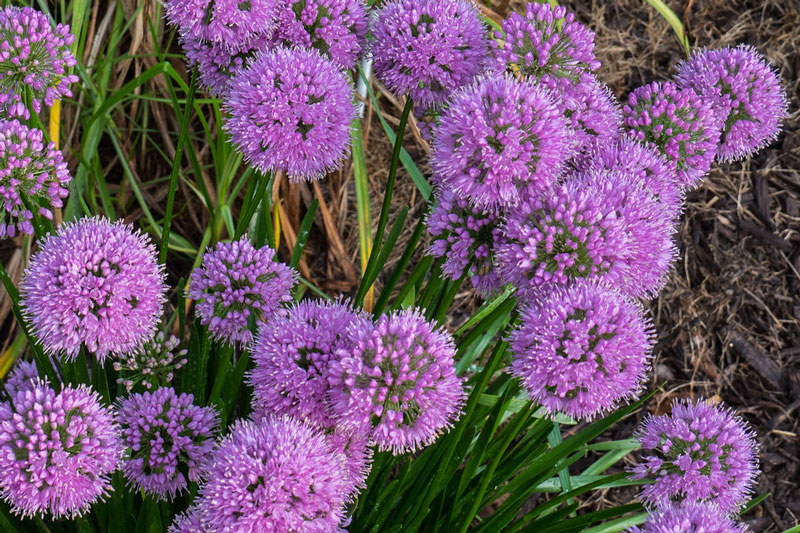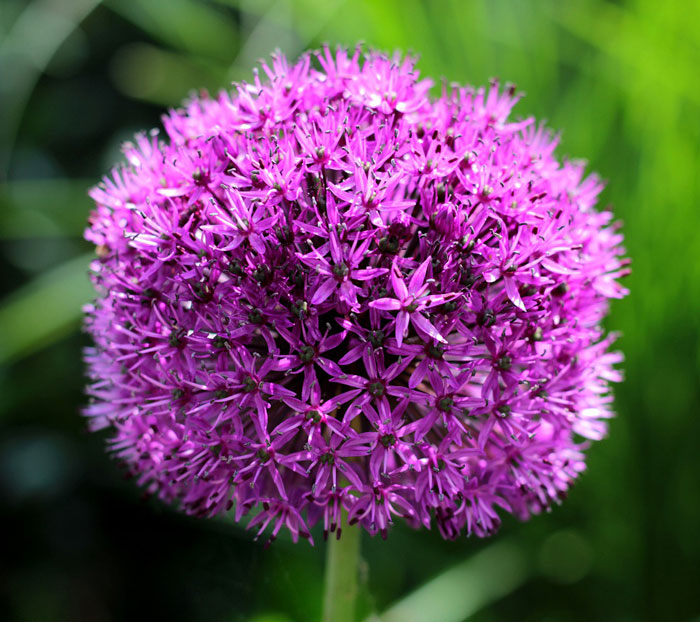Taking an environmentally sensitive approach to pest management
Alliums Create Landscape Interest
Published: August 9, 2019

Allium 'Millenium' – credit F.D. Richards
Among the many useful ornamental plants often overlooked in the landscape are the alliums. Allium is a genus of more than 700 species in the Amaryllidaceae (amaryllis) plant family. Perhaps best known are the alliums used for food. They include onion, shallot and scallion (Allium cepa), garlic (A. sativum), leek (A. ampeloprasum) and chives (A. schoenoprasum). Although any of these might be judged by some to be attractive, a second group alliums prized for their ornamental value is the subject of this article.
When planted in the fall, ornamental alliums will flower the following spring. Spring-planted alliums started from divisions or started plants from a greenhouse tend to flower the first year. Most alliums flower in May, June or early July, depending upon species. After flowering, the foliage dies back leaving a dormant underground bulb behind. Most, but not all ornamental alliums, have a slightly garlic or onion-like aroma when the foliage is handled.

Allium giganteum
Probably the best known ornamental allium is Allium giganteum, or giant onion. This plant produces a round head of violet flowers on flower stalks (scapes) that often reach six feet in height. The ball of flowers is about six inches in diameter and, when planted in mass, can be very spectacular in the garden. The cultivar 'Globemaster' is an interspecific hybrid between A. giganteum and A. cristophii. Its flower heads are even larger (eight to ten inches) than A. giganteum with florets more tightly packed. The result is an imposing, brilliant purple flower that reflects shades of violet, making for a stunning garden display.
From another species of allium (Allium aflatunense) comes an ornamental cultivar called 'Purple Sensation'. It produces purple star-like florets tightly packed into a round flower head about the size of a grapefruit. Scapes of 'Purple Sensation' are shorter than those of A. giganteum, reaching a height of about three feet. Flowers tend to appear early in the growing season.
'Star of Persia' is a name sometimes given to the afore-mentioned Allium christophii. This species produces pale purplish-blue flower heads up to ten inches in diameter with star-shaped florets. Florets tend to be a bit more sparsely packed than those in other large-flowered alliums. Scapes average about two feet in height.
Not all of the alliums are large and spectacular. Allium sphaerocephalon, or drumstick allium, grows about two feet in height and produces an abundance of reddish-purple, cone-shaped flowers. Appearing in early summer, flower heads average a bit over two inches in diameter on scapes about 20 inches in height.
There are several alliums that grow to a height of only eight to twelve inches, making them more suitable for planting in the front of a border or, possibly, as an edging. The culinary herb Allium schoenoprasum, or chives, is one of these. Its pinkish-purple flowers average about one inch in diameter and are borne on scapes about twenty inches in height. Its hollow, grass-like leaves are shorter than its scapes and can be used for culinary purposes in a variety of ways.
Allium moly, or golden garlic, is a small plant that produces bright yellow flowers and is suitable for a rock garden or for naturalizing. It grows to a height of only about twelve inches and is one of the few yellow-flowered alliums.
'Blue Eddy' is another small ornamental allium selected from the species Allium scenscens. Its name reflects the bluish hue of its (somewhat) twisted foliage. It produces small, lavender-pink flower heads about an inch and one-half in diameter on scapes that achieve a height of about twelve inches.
Perhaps the most widely publicized allium is 'Millenium' which is a cross between Allium nutans and A. lusitanicum. Selected for its compact growth habit and abundance of rose-purple flower heads, 'Millenium' was designated by the Perennial Plant Association's as its 2018 Perennial of the Year. Very floriferous, it tends to bloom later in the season than other alliums for extended color in the garden.
Like onions, alliums need abundant amounts of direct sunlight in order to thrive in the garden. Well-drained soil also is a must for survival of the bulb, especially during the winter. If garden soils are fairly heavy, raised beds amended with organic matter can greatly increase drainage. Alliums planted in poorly-drained soil tend to be short-lived. Considered to be drought tolerant, most alliums require only infrequent watering and should be grown on the "dry side".
Alliums are virtually pest free and seem to be shunned by both deer and rodents. Contrastingly, the flowers of allium are attractive to pollinators, especially bees and butterflies.
As is the case with most flowering perennials, alliums require occasional rejuvenation through division. In late summer, after its leaves have dies back, carefully lift the clump of bulbs with a spade or garden fork. Remove small, outer bublets and grow them in flower pots for additional plants in future years. Carefully separate the remaining bulbs and discard any that have been damaged. If replanted, the latter are prone to decay. Replant some sound bulbs in the same location and find new homes for the remainder.
Subscribe to receive similar articles sent directly to your inbox!
- Herb Gardening in Autumn (10/04/24)
- For the Love of Garlic (09/08/22)
- Alliums Create Landscape Interest (08/09/19)
REVISED: August 9, 2019